tow MITSUBISHI ECLIPSE CROSS 2018 (in English) User Guide
[x] Cancel search | Manufacturer: MITSUBISHI, Model Year: 2018, Model line: ECLIPSE CROSS, Model: MITSUBISHI ECLIPSE CROSS 2018Pages: 417, PDF Size: 74.06 MB
Page 105 of 417
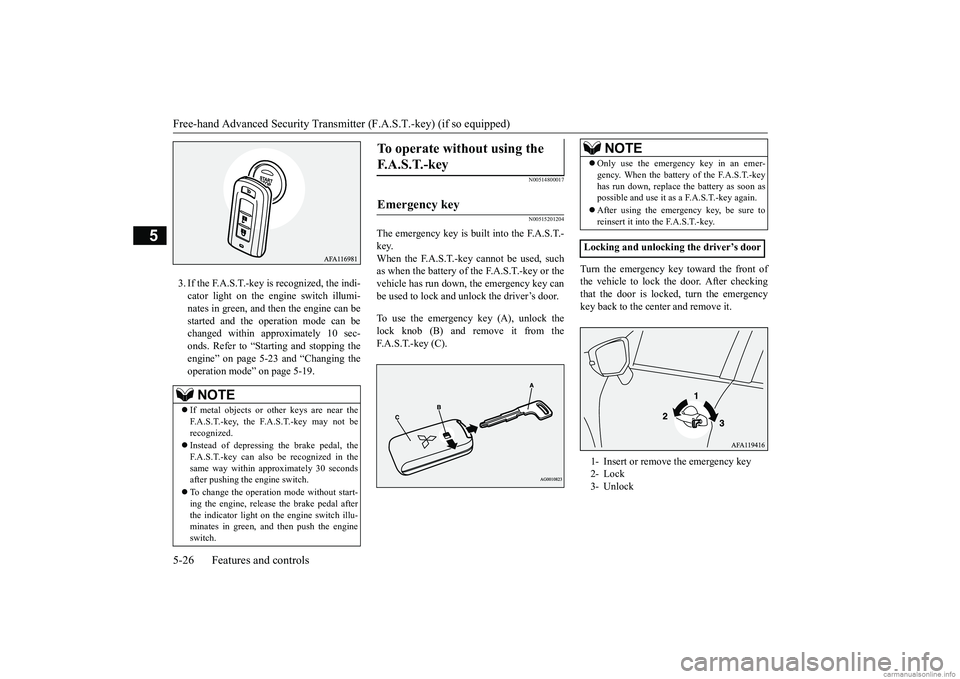
Free-hand Advanced Security Transmitter (F.A.S.T.-key) (if so equipped) 5-26 Features and controls
5
3. If the F.A.S.T.-key is recognized, the indi- cator light on the engine switch illumi-nates in green, and then the engine can be started and the operation mode can be changed within approximately 10 sec-onds. Refer to “Starting and stopping the engine” on page 5-23 and “Changing the operation mode” on page 5-19.
N00514800017 N00515201204
The emergency key is built into the F.A.S.T.- key. When the F.A.S.T.-key cannot be used, such as when the battery of the F.A.S.T.-key or thevehicle has run down, the emergency key canbe used to lock and unlock the driver’s door. To use the emergency key (A), unlock the lock knob (B) and remove it from the F.A.S.T.-key (C).
Turn the emergency key toward the front of the vehicle to lock the door. After checking that the door is locked, turn the emergencykey back to the center and remove it.
NOTE
If metal objects or other keys are near the F.A.S.T.-key, the F.A.S.T.-key may not be recognized. Instead of depressing the brake pedal, the F.A.S.T.-key can also be recognized in the same way within approximately 30 secondsafter pushing the engine switch. To change the operation mode without start- ing the engine, release the brake pedal after the indicator light on the engine switch illu- minates in green, and then push the engineswitch.
To operate without using the F. A . S . T. - k e y
Emergency key
NOTE
Only use the emergency key in an emer- gency. When the battery of the F.A.S.T.-key has run down, replace the battery as soon as possible and use it as a F.A.S.T.-key again. After using the emergency key, be sure to reinsert it into the F.A.S.T.-key.
Locking and unlocking the driver’s door 1- Insert or remove the emergency key 2- Lock 3- Unlock
BK0252700US.bo
ok 26 ページ 2017年10月4日 水曜日 午後4時54分
Page 110 of 417
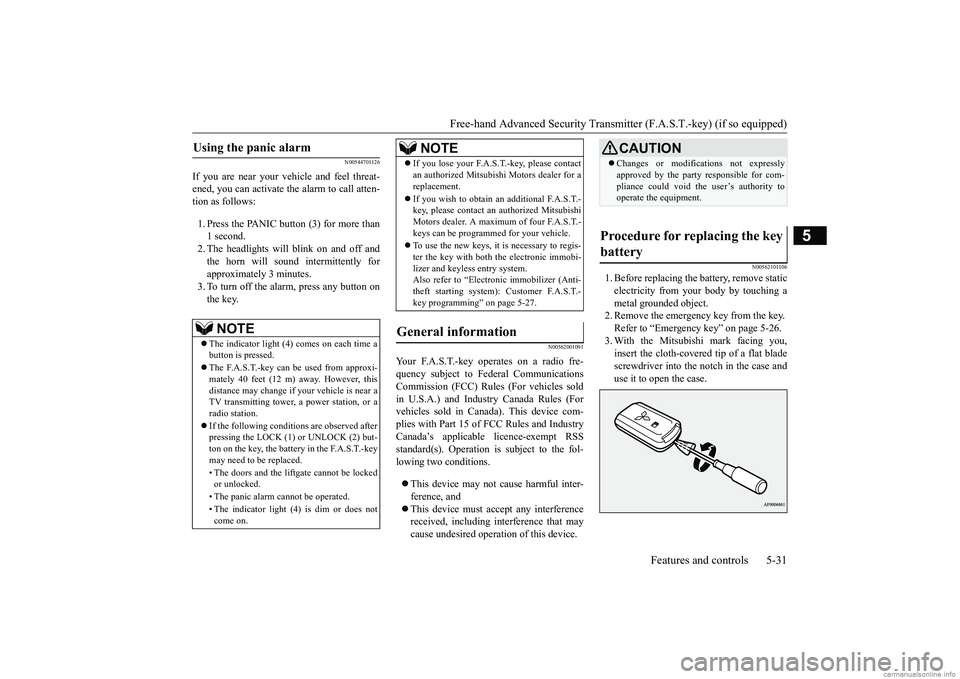
Free-hand Advanced Security Transmit
ter (F.A.S.T.-key) (if so equipped)
Features and controls 5-31
5
N00544701126
If you are near your vehicle and feel threat- ened, you can activate the alarm to call atten-tion as follows: 1. Press the PANIC button (3) for more than 1 second. 2. The headlights will blink on and off andthe horn will sound intermittently for approximately 3 minutes. 3. To turn off the alarm, press any button onthe key.
N00562001091
Your F.A.S.T.-key operates on a radio fre- quency subject to Federal Communications Commission (FCC) Rules (For vehicles soldin U.S.A.) and Industry Canada Rules (For vehicles sold in Canada). This device com- plies with Part 15 of FCC Rules and IndustryCanada’s applicable licence-exempt RSS standard(s). Operation is subject to the fol- lowing two conditions. This device may not cause harmful inter- ference, and This device must accept any interference received, including interference that maycause undesired operation of this device.
N00562101106
1. Before replacing the battery, remove staticelectricity from your body by touching ametal grounded object. 2. Remove the emergency key from the key. Refer to “Emergency key” on page 5-26.3. With the Mitsubishi mark facing you, insert the cloth-covered tip of a flat blade screwdriver into the notch in the case anduse it to open the case.
Using the panic alarm
NOTE
The indicator light (4) comes on each time a button is pressed. The F.A.S.T.-key can be used from approxi- mately 40 feet (12 m) away. However, this distance may change if your vehicle is near aTV transmitting tower, a power station, or a radio station. If the following conditions are observed after pressing the LOCK (1) or UNLOCK (2) but- ton on the key, the battery in the F.A.S.T.-key may need to be replaced. • The doors and the liftgate cannot be locked or unlocked. • The panic alarm cannot be operated. • The indicator light (4) is dim or does not come on.
If you lose your F.A.S.T.-key, please contact an authorized Mitsubishi Motors dealer for a replacement. If you wish to obtain
an additional F.A.S.T.-
key, please contact an authorized Mitsubishi Motors dealer. A maximum of four F.A.S.T.- keys can be programmed for your vehicle. To use the new keys, it is necessary to regis- ter the key with both the electronic immobi-lizer and keyless entry system. Also refer to “Electronic immobilizer (Anti- theft starting system): Customer F.A.S.T.-key programming” on page 5-27.
General information
NOTE
CAUTION Changes or modifications not expressly approved by the party responsible for com- pliance could void the user’s authority to operate the equipment.
Procedure for replacing the key battery
BK0252700US.bo
ok 31 ページ 2017年10月4日 水曜日 午後4時54分
Page 111 of 417
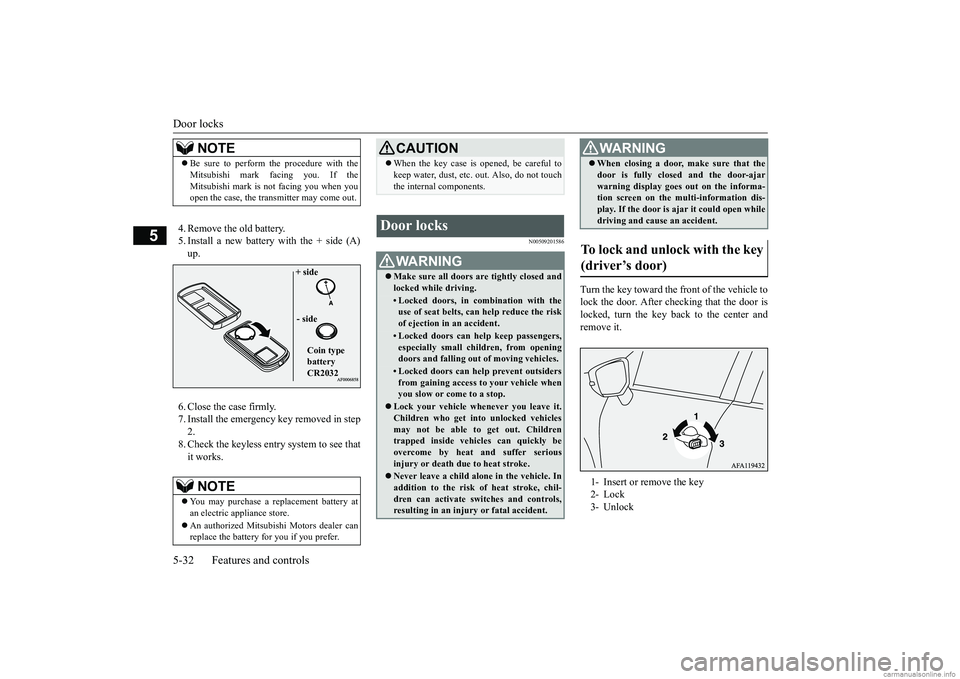
Door locks 5-32 Features and controls
5
4. Remove the old battery. 5. Install a new battery with the + side (A) up. 6. Close the case firmly. 7. Install the emergency key removed in step 2.8. Check the keyless entry system to see that it works.
N00509201586
Turn the key toward the front of the vehicle tolock the door. After checking that the door is locked, turn the key back to the center andremove it.
NOTE
Be sure to perform the procedure with the Mitsubishi mark facing you. If the Mitsubishi mark is not facing you when you open the case, the transmitter may come out.NOTE
You may purchase a replacement battery at an electric appliance store. An authorized Mitsubishi Motors dealer can replace the battery for you if you prefer.
+ side - side Coin type battery CR2032
CAUTION When the key case is opened, be careful to keep water, dust, etc. out. Also, do not touch the internal components.
Door locks
WA R N I N G Make sure all doors are tightly closed and locked while driving.• Locked doors, in combination with theuse of seat belts, can help reduce the riskof ejection in an accident.• Locked doors can help keep passengers,especially small children, from opening doors and falling out of moving vehicles.• Locked doors can help prevent outsidersfrom gaining access to your vehicle when you slow or come to a stop.
Lock your vehicle whenever you leave it. Children who get into unlocked vehiclesmay not be able to get out. Children trapped inside vehicles can quickly be overcome by heat and suffer serious injury or death due to heat stroke. Never leave a child alone in the vehicle. In addition to the risk of heat stroke, chil- dren can activate switches and controls,resulting in an injury or fatal accident.
When closing a door, make sure that the door is fully closed
and the door-ajar
warning display goes out on the informa- tion screen on the multi-information dis- play. If the door is ajar it could open whiledriving and cause an accident.
To lock and unlock with the key (driver’s door) 1- Insert or remove the key 2- Lock 3- UnlockWA R N I N G
BK0252700US.bo
ok 32 ページ 2017年10月4日 水曜日 午後4時54分
Page 126 of 417
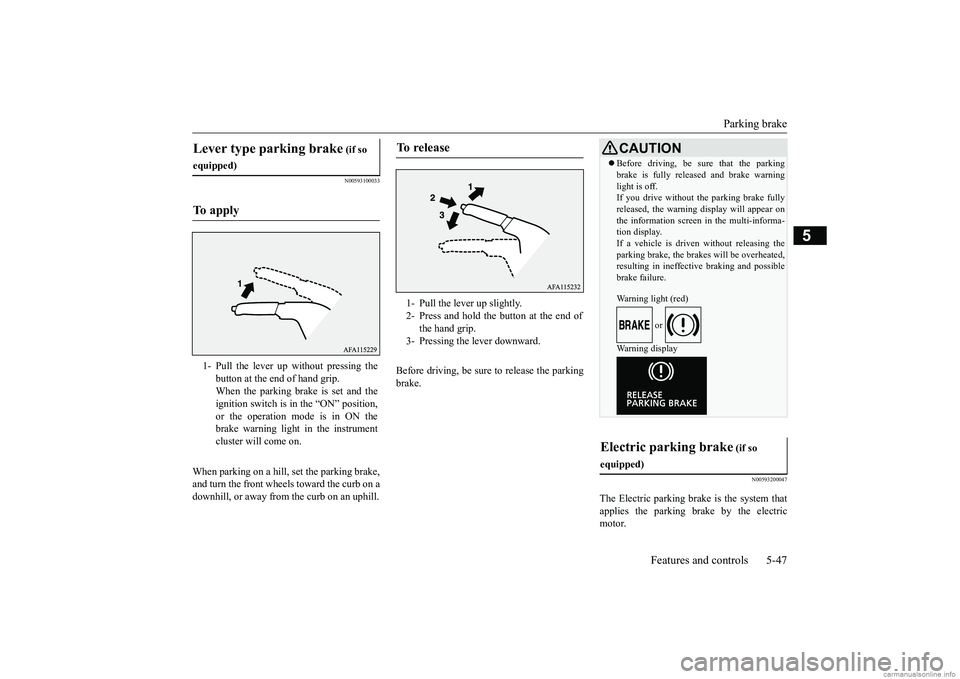
Parking brake
Features and controls 5-47
5
N00593100033
When parking on a hill, set the parking brake, and turn the front wheels toward the curb on a downhill, or away from the curb on an uphill.
Before driving, be sure to release the parking brake.
N00593200047
The Electric parking brake is the system thatapplies the parking brake by the electric motor.
Lever type parking brake
(if so
equipped)To apply
1- Pull the lever up without pressing the
button at the end of hand grip.When the parking brake is set and the ignition switch is in the “ON” position, or the operation mode is in ON thebrake warning light in the instrument cluster will come on.
To release
1- Pull the lever up slightly. 2- Press and hold the button at the end of
the hand grip.
3- Pressing the lever downward.
CAUTION Before driving, be sure that the parking brake is fully released and brake warning light is off. If you drive without the parking brake fully released, the warning display will appear onthe information screen in the multi-informa- tion display. If a vehicle is driven without releasing theparking brake, the brakes will be overheated, resulting in ineffective braking and possible brake failure. Warning light (red)
or
Warning display
Electric parking brake
(if so
equipped)
BK0252700US.bo
ok 47 ページ 2017年10月4日 水曜日 午後4時54分
Page 127 of 417
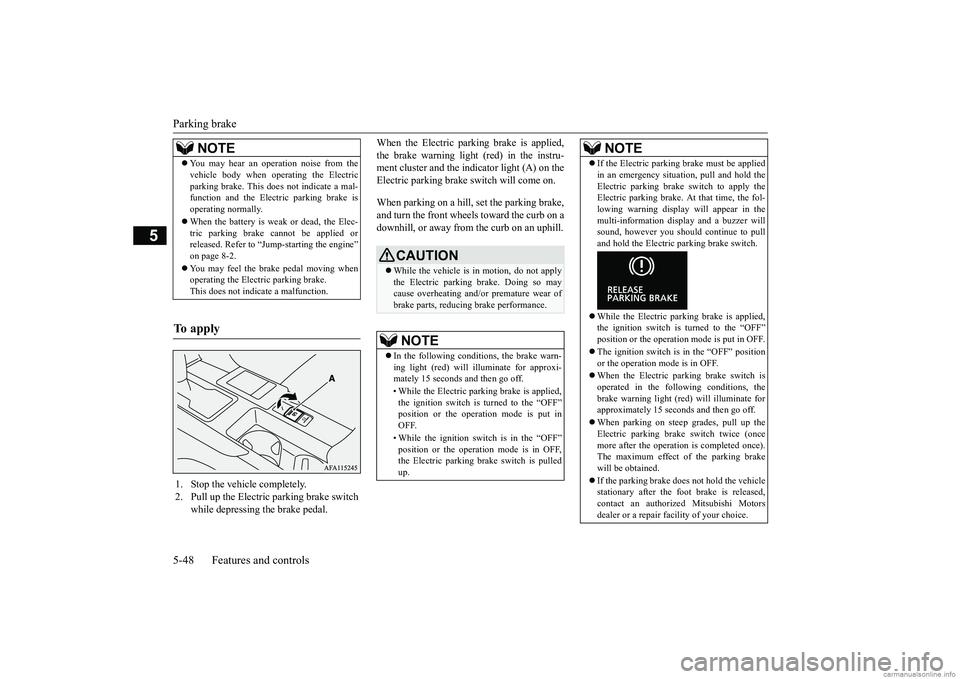
Parking brake 5-48 Features and controls
5
When the Electric parking brake is applied, the brake warning light (red) in the instru- ment cluster and the indicator light (A) on the Electric parking brake switch will come on. When parking on a hill, set the parking brake, and turn the front wheels toward the curb on a downhill, or away from the curb on an uphill.
NOTE
You may hear an operation noise from the vehicle body when operating the Electric parking brake. This does not indicate a mal- function and the Electric parking brake is operating normally. When the battery is weak or dead, the Elec- tric parking brake cannot be applied orreleased. Refer to “Jump-starting the engine” on page 8-2. You may feel the brake pedal moving when operating the Electric parking brake. This does not indicate a malfunction.
To apply
1. Stop the vehicle completely. 2. Pull up the Electric parking brake switch
while depressing the brake pedal.
CAUTION While the vehicle is in motion, do not apply the Electric parking brake. Doing so may cause overheating and/or premature wear of brake parts, reducing brake performance. NOTE
In the following conditions, the brake warn- ing light (red) will illuminate for approxi- mately 15 seconds and then go off. • While the Electric parking brake is applied, the ignition switch is turned to the “OFF”position or the operation mode is put in OFF. • While the ignition switch is in the “OFF” position or the operation mode is in OFF, the Electric parking brake switch is pulled up.
If the Electric parking brake must be applied in an emergency situation, pull and hold the Electric parking brake switch to apply the Electric parking brake. At that time, the fol- lowing warning display will appear in themulti-information display and a buzzer will sound, however you should continue to pull and hold the Electric parking brake switch. While the Electric parking brake is applied, the ignition switch is turned to the “OFF” position or the operation mode is put in OFF. The ignition switch is in the “OFF” position or the operation mode is in OFF. When the Electric parking brake switch is operated in the following conditions, thebrake warning light (red) will illuminate for approximately 15 seconds and then go off. When parking on steep grades, pull up the Electric parking brake switch twice (once more after the operation is completed once).The maximum effect of the parking brake will be obtained. If the parking brake does not hold the vehicle stationary after the foot brake is released,contact an authorized Mitsubishi Motors dealer or a repair facility of your choice.NOTE
BK0252700US.bo
ok 48 ページ 2017年10月4日 水曜日 午後4時54分
Page 133 of 417
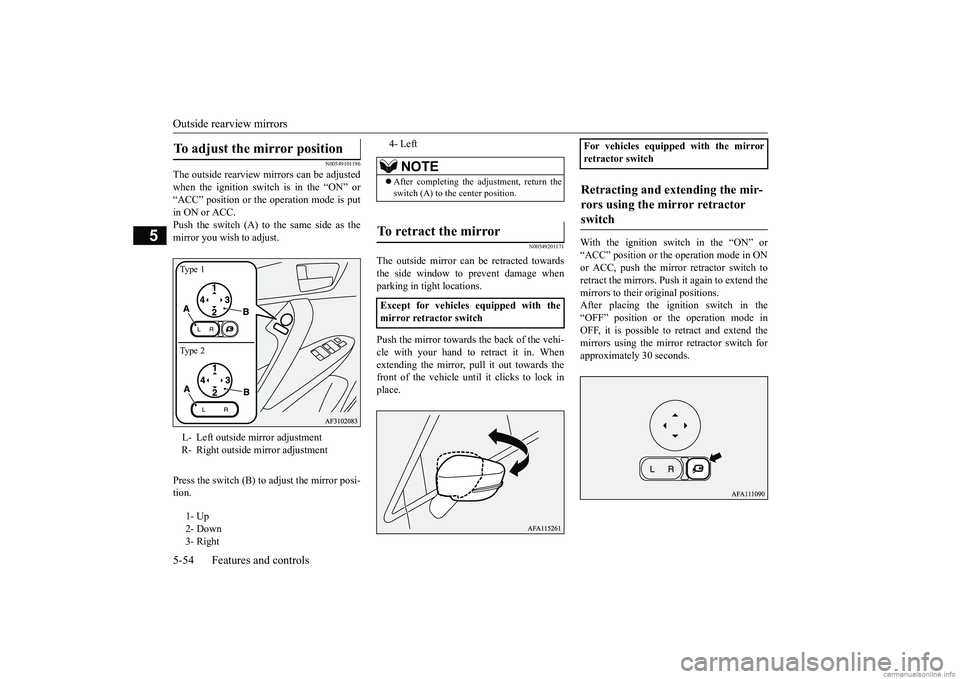
Outside rearview mirrors 5-54 Features and controls
5
N00549101196
The outside rearview mirrors can be adjusted when the ignition switch is in the “ON” or“ACC” position or the operation mode is put in ON or ACC. Push the switch (A) to the same side as themirror you wish to adjust. Press the switch (B) to adjust the mirror posi- tion.
N00549201171
The outside mirror can be retracted towards the side window to prevent damage whenparking in tight locations. Push the mirror towards the back of the vehi- cle with your hand to retract it in. Whenextending the mirror, pull it out towards the front of the vehicle until it clicks to lock in place.
With the ignition switch in the “ON” or “ACC” position or the
operation mode in ON
or ACC, push the mirror retractor switch toretract the mirrors. Push it again to extend themirrors to their original positions. After placing the ignition switch in the “OFF” position or the operation mode inOFF, it is possible to retract and extend the mirrors using the mirror retractor switch for approximately 30 seconds.
To adjust the mirror position L- Left outside mirror adjustment R- Right outside mirror adjustment 1- Up 2- Down 3- RightType 1 Type 2
4- Left
NOTE
After completing the adjustment, return the switch (A) to the center position.
To retract the mirror Except for vehicles equipped with the mirror retractor switch
For vehicles equipped with the mirrorretractor switchRetracting and extending the mir- rors using the mirror retractor switch
BK0252700US.bo
ok 54 ページ 2017年10月4日 水曜日 午後4時54分
Page 149 of 417
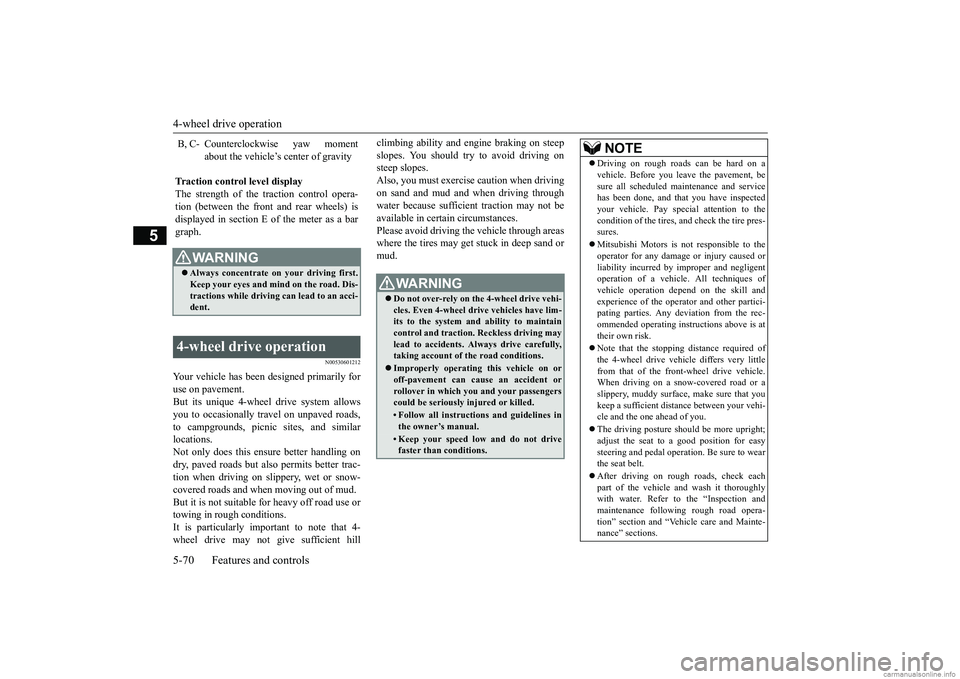
4-wheel drive operation 5-70 Features and controls
5
N00530601212
Your vehicle has been designed primarily for use on pavement. But its unique 4-wheel drive system allowsyou to occasionally travel on unpaved roads, to campgrounds, picnic sites, and similar locations.Not only does this ensure better handling on dry, paved roads but also permits better trac- tion when driving on slippery, wet or snow-covered roads and when moving out of mud. But it is not suitable for heavy off road use or towing in rough conditions.It is particularly important to note that 4- wheel drive may not give sufficient hill
climbing ability and engine braking on steep slopes. You should try to avoid driving on steep slopes. Also, you must exercise caution when drivingon sand and mud and when driving through water because sufficient traction may not be available in certain circumstances.Please avoid driving the vehicle through areas where the tires may get stuck in deep sand or mud.
B, C- Counterclockwise yaw moment
about the vehicle’s center of gravity
Traction control level display The strength of the traction control opera-tion (between the front and rear wheels) is displayed in section E of the meter as a bar graph.
WA R N I N G Always concentrate on your driving first. Keep your eyes and mind on the road. Dis-tractions while driving can lead to an acci- dent.
4-wheel drive operation
WA R N I N G Do not over-rely on the 4-wheel drive vehi- cles. Even 4-wheel drive vehicles have lim-its to the system and ability to maintain control and traction. Reckless driving may lead to accidents. Always drive carefully,taking account of the road conditions. Improperly operating this vehicle on or off-pavement can cause an accident or rollover in which you and your passengers could be seriously injured or killed.• Follow all instructions and guidelines inthe owner’s manual.• Keep your speed low and do not drivefaster than conditions.
NOTE
Driving on rough roads can be hard on a vehicle. Before you leave the pavement, be sure all scheduled maintenance and service has been done, and that you have inspected your vehicle. Pay special attention to thecondition of the tires, and check the tire pres- sures. Mitsubishi Motors is not responsible to the operator for any damage or injury caused or liability incurred by improper and negligentoperation of a vehicle. All techniques of vehicle operation depend on the skill and experience of the operator and other partici-pating parties. Any deviation from the rec- ommended operating instructions above is at their own risk. Note that the stopping distance required of the 4-wheel drive vehicle differs very littlefrom that of the front-wheel drive vehicle. When driving on a snow-covered road or a slippery, muddy surface, make sure that youkeep a sufficient distance between your vehi- cle and the one ahead of you. The driving posture should be more upright; adjust the seat to a good position for easy steering and pedal operation. Be sure to wearthe seat belt. After driving on rough roads, check each part of the vehicle and wash it thoroughly with water. Refer to the “Inspection andmaintenance following rough road opera- tion” section and “Vehicle care and Mainte- nance” sections.
BK0252700US.bo
ok 70 ページ 2017年10月4日 水曜日 午後4時54分
Page 152 of 417
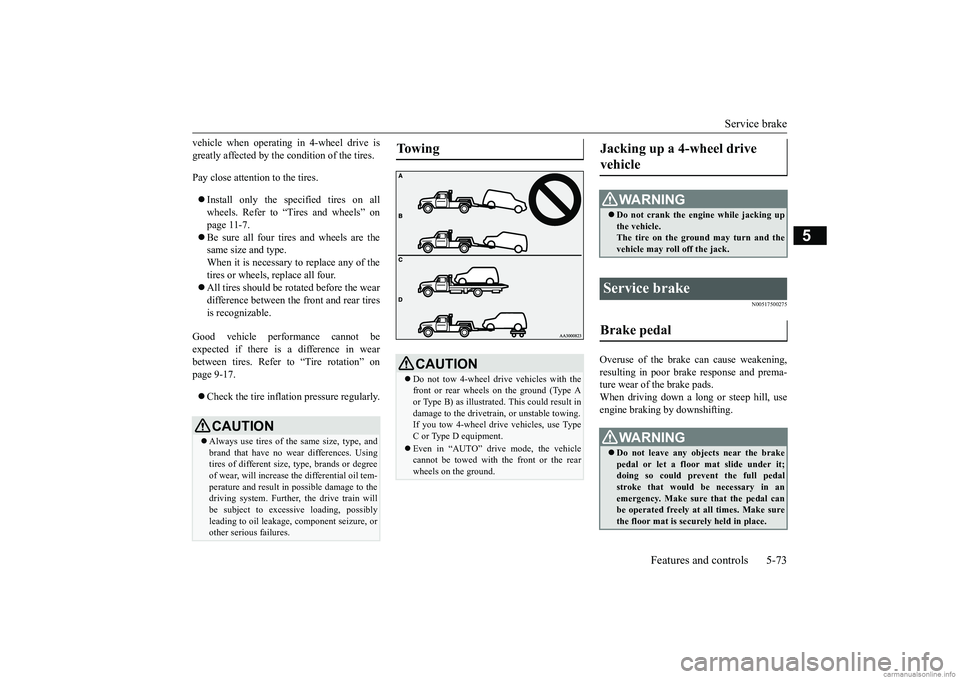
Service brake
Features and controls 5-73
5
vehicle when operating in 4-wheel drive is greatly affected by the condition of the tires. Pay close attention to the tires. Install only the specified tires on all wheels. Refer to “Tires and wheels” on page 11-7. Be sure all four tires and wheels are the same size and type. When it is necessary to replace any of thetires or wheels, replace all four. All tires should be rotated before the wear difference between the front and rear tires is recognizable.
Good vehicle performance cannot be expected if there is a difference in wear between tires. Refer to “Tire rotation” on page 9-17. Check the tire inflation pressure regularly.
N00517500275
Overuse of the brake can cause weakening, resulting in poor brake response and prema- ture wear of the brake pads.When driving down a long or steep hill, use engine braking by downshifting.
CAUTION Always use tires of the same size, type, and brand that have no wear differences. Using tires of different size, type, brands or degree of wear, will increase the differential oil tem- perature and result in possible damage to thedriving system. Further, the drive train will be subject to excessive loading, possibly leading to oil leakage, component seizure, orother serious failures.
To w i n g
CAUTION Do not tow 4-wheel drive vehicles with the front or rear wheels on the ground (Type Aor Type B) as illustrated. This could result in damage to the drivetrain, or unstable towing. If you tow 4-wheel dr
ive vehicles, use Type
C or Type D equipment. Even in “AUTO” drive mode, the vehicle cannot be towed with the front or the rear wheels on the ground.
Jacking up a 4-wheel drive vehicle
WA R N I N G Do not crank the engine while jacking up the vehicle.The tire on the ground may turn and the vehicle may roll off the jack.
Service brake Brake pedal
WA R N I N G Do not leave any objects near the brake pedal or let a floor mat slide under it; doing so could prevent the full pedal stroke that would be necessary in anemergency. Make sure that the pedal can be operated freely at all times. Make sure the floor mat is securely held in place.
BK0252700US.bo
ok 73 ページ 2017年10月4日 水曜日 午後4時54分
Page 163 of 417
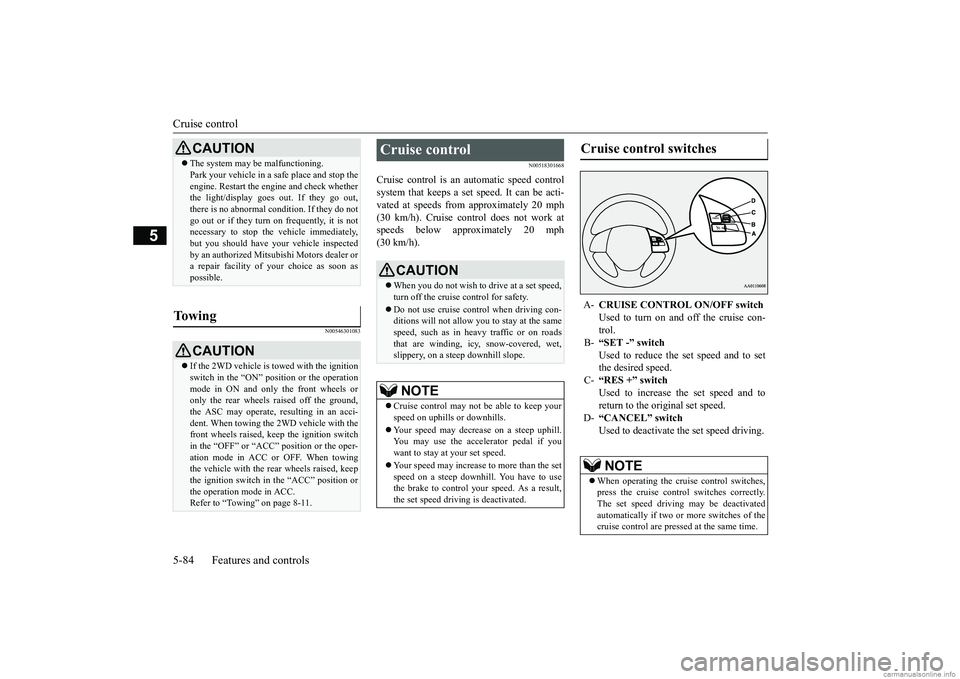
Cruise control 5-84 Features and controls
5
N00546301083
N00518301668
Cruise control is an automatic speed control system that keeps a set speed. It can be acti-vated at speeds from approximately 20 mph (30 km/h). Cruise control does not work at speeds below approximately 20 mph(30 km/h).
CAUTION The system may be malfunctioning. Park your vehicle in a safe place and stop the engine. Restart the engine and check whether the light/display goes out. If they go out, there is no abnormal condition. If they do notgo out or if they turn
on frequently, it is not
necessary to stop the vehicle immediately, but you should have your vehicle inspectedby an authorized Mitsubishi Motors dealer or a repair facility of
your choice as soon as
possible.
To w i n g
CAUTION If the 2WD vehicle is towed with the ignition switch in the “ON” position or the operation mode in ON and only the front wheels oronly the rear wheels raised off the ground, the ASC may operate, resulting in an acci- dent. When towing the 2WD vehicle with thefront wheels raised, keep the ignition switch in the “OFF” or “ACC” position or the oper- ation mode in ACC or OFF. When towing the vehicle with the rear wheels raised, keep the ignition switch in the “ACC” position orthe operation mode in ACC. Refer to “Towing” on page 8-11.
Cruise control
CAUTION When you do not wish to drive at a set speed, turn off the cruise control for safety. Do not use cruise control when driving con- ditions will not allow you to stay at the same speed, such as in heavy traffic or on roadsthat are winding, icy, snow-covered, wet, slippery, on a steep downhill slope.NOTE
Cruise control may not be able to keep your speed on uphills or downhills. Your speed may decrease on a steep uphill. You may use the accelerator pedal if you want to stay at your set speed. Your speed may increase to more than the set speed on a steep downhill. You have to usethe brake to control your speed. As a result, the set speed driving is deactivated.
Cruise control switches A-
CRUISE CONTROL ON/OFF switch Used to turn on and off the cruise con- trol.
B-
“SET -” switch Used to reduce the set speed and to set the desired speed.
C-
“RES +” switch Used to increase the set speed and toreturn to the original set speed.
D-
“CANCEL” switch Used to deactivate the set speed driving.NOTE
When operating the cruise control switches, press the cruise control switches correctly. The set speed driving may be deactivated automatically if two or more switches of thecruise control are pressed at the same time.
BK0252700US.bo
ok 84 ページ 2017年10月4日 水曜日 午後4時54分
Page 172 of 417
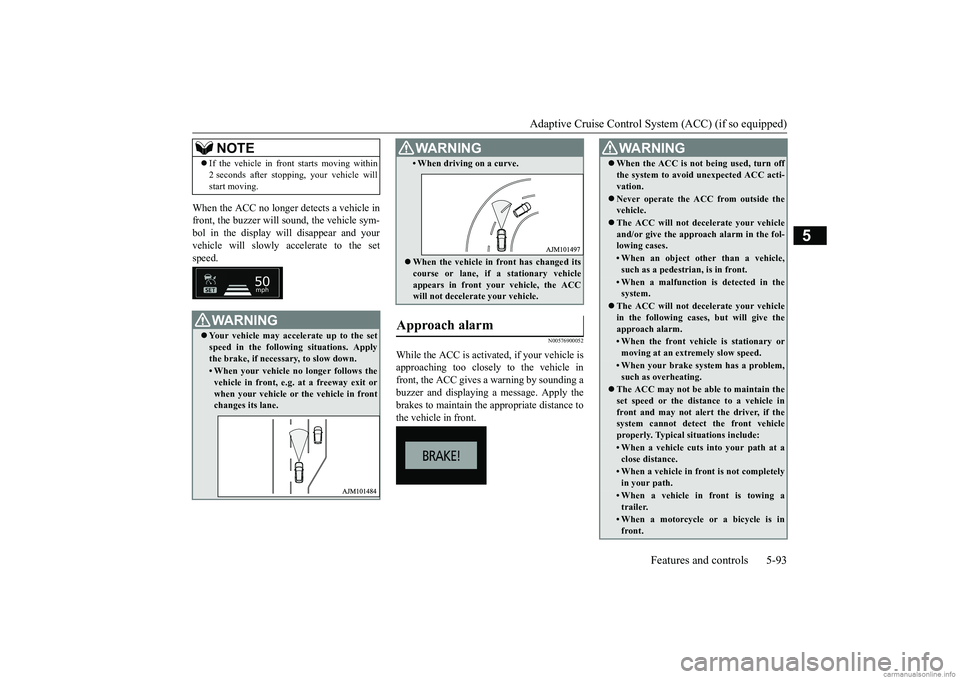
Adaptive Cruise Control System (ACC) (if so equipped)
Features and controls 5-93
5
When the ACC no longer detects a vehicle in front, the buzzer will sound, the vehicle sym- bol in the display will disappear and your vehicle will slowly accelerate to the setspeed.
N00576900052
While the ACC is activat
ed, if your vehicle is
approaching too closely to the vehicle infront, the ACC gives a warning by sounding a buzzer and displaying a message. Apply the brakes to maintain the appropriate distance tothe vehicle in front.
If the vehicle in front starts moving within 2 seconds after stopping, your vehicle will start moving.WA R N I N G Your vehicle may accelerate up to the set speed in the following situations. Apply the brake, if necessary, to slow down.• When your vehicle no longer follows thevehicle in front, e.g. at a freeway exit or when your vehicle or the vehicle in frontchanges its lane.NOTE
• When driving on a curve. When the vehicle in front has changed its course or lane, if a stationary vehicle appears in front your vehicle, the ACC will not decelerate your vehicle.
Approach alarm
WA R N I N G
WA R N I N G When the ACC is not being used, turn off the system to avoid unexpected ACC acti- vation. Never operate the ACC from outside the vehicle. The ACC will not decelerate your vehicle and/or give the approach alarm in the fol- lowing cases.• When an object other than a vehicle,such as a pedestrian, is in front. • When a malfunction is detected in thesystem.
The ACC will not decelerate your vehicle in the following cases, but will give the approach alarm.• When the front vehicle is stationary ormoving at an extremely slow speed.• When your brake system has a problem,such as overheating.
The ACC may not be able to maintain the set speed or the distance to a vehicle infront and may not alert the driver, if the system cannot detect the front vehicle properly. Typical situations include: • When a vehicle cuts into your path at aclose distance.• When a vehicle in front is not completelyin your path.• When a vehicle in front is towing atrailer.• When a motorcycle or a bicycle is infront.
BK0252700US.bo
ok 93 ページ 2017年10月4日 水曜日 午後4時54分